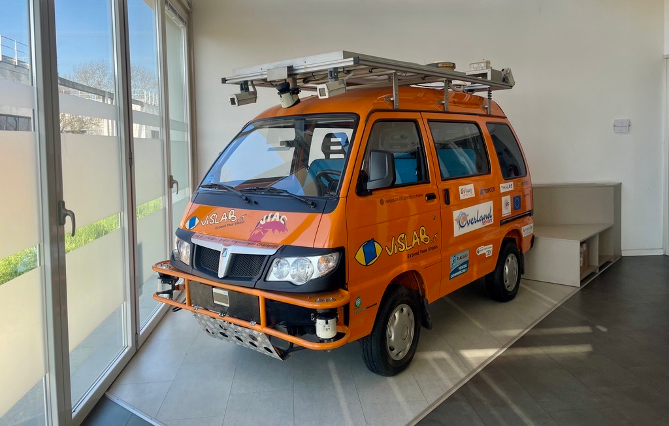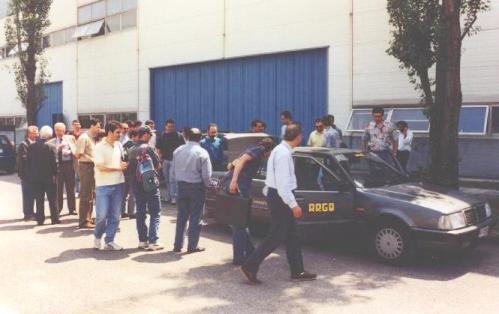Fifteen years ago, before we were acquired by Ambarella and became one of the company’s automotive R&D centers, VisLab sent four driverless vehicles from Parma to Shanghai. Traveling over 15,000 kilometers from July to October of 2010, the vehicles navigated across nine different nations and two continents —testing autonomous driving functions. That journey, part of the VisLab Intercontinental Autonomous Challenge (VIAC), was the world’s first, and remains, to this day, the only intercontinental autonomous driving experiment ever completed.
Last month, one of those historic vehicles took its place in autonomous automotive history, as part of the Italian National Automobile Museum (MAUTO)’s new Spazio Futuro (The Future Unfolds) exhibition. The exhibit celebrates an ever-evolving dialogue between the past, present, and future of mobility, and I’m honored that Ambarella and VisLab were chosen to be a part of this rich history.

Visitors to the exhibit will be able to see our above original VIAC prototype, alongside video projections, innovative models and interactive installations illustrating the evolution of autonomous driving. It’s a moment of great pride—for me personally, and for our team in Parma. What was once a radical experiment has now been recognized as a foundational milestone in the global journey toward increasing levels of autonomy.

Yet, our story didn’t begin with VIAC. Back in 1998, in one of the world’s first autonomous driving experiments ever conducted, we outfitted a Lancia Thema with a PC and a pair of videophone cameras and drove 2,000 kilometers around Italy in semi-autonomous mode on open roads. In 2005, we joined the DARPA Grand Challenge, with our TerraMax vehicle completing a fully autonomous 132-mile route across the Mojave Desert. In 2013, we marked another world first with our BRAiVE vehicle driving autonomously, with no one in the driver’s seat, through downtown Parma.

At every stage, VisLab and Ambarella have continued to innovate and stay ahead of the curve. Since becoming part of Ambarella in 2015, we’ve brought together VisLab’s deep experience in autonomous driving with Ambarella’s cutting-edge AI semiconductor designs. Each year, we showcase our continuing progress with new driving demos during the Consumer Electronics Show (CES) in Las Vegas, as shown in the above fully autonomous example during CES 2024. We’re refining vision and radar-based perception, path planning, sensor fusion and efficient edge computing—preparing for safer, smarter vehicles of the future.
To reach this future, we’re pursuing an approach that’s lean, scalable, and deeply informed by real-world complexity. We have already demonstrated on the public roads of multiple continents that our CV3-AD system-on-chip family, combined with our AD software stack (installed in our R&D vehicles) can achieve L2+ to L4 autonomy using one or two, power-efficient processing chips. For our AD stack, the shift to becoming fully deep learning-based has transformed not only how our systems see the world, but how they understand it. The perception, decision-making and planning that used to rely on traditional algorithms and pre-loaded HD maps is now driven by deep learning AI processing capable of leveraging massive, real-time datasets for increased performance. Furthermore, one of our biggest technical challenges today is modeling behavioral prediction. This requires not just physical sensing, but large-scale real-world data and neural networks capable of anticipating human behavior. It’s a hard problem, but one we’re deeply committed to solving.
The following picture shows an example result of the precise detections that we’ve achieved for road objects and their classification, using real-time neural image processing on a single CV3-AD chip:

Even with all the progress we’ve made, our historic VIAC vehicle will always be special. Not because of what it was, but because of what it proved 15 years ago. Autonomy wasn’t science fiction, it was achievable. And it could be done with ingenuity, grit, and a team of researchers from Parma who had the courage to follow through on their vision.
I invite you to visit the Spazio Futuro exhibit at MAUTO and see the vehicle that helped the world change how we think about transportation. It’s more than a museum piece—it’s a reminder that the future is built by those willing to experiment early, iterate relentlessly, and bring bold ideas to the road.
